27. Dezember 2020
Pursuit, a take on personal OKRs
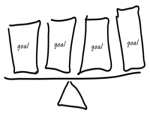 The year 2020 taught me again how powerful good habits are, once established. How important it is to continuously do the many small steps that are required to achieve goals, from smaller to bigger goals. I wrote an app─nicknamed “pursuit“─which helps me to formulate, commit, and measure the progress towards goals. I will share the ideas with you, may it inspire you to progress towards your goals in 2021.
The year 2020 taught me again how powerful good habits are, once established. How important it is to continuously do the many small steps that are required to achieve goals, from smaller to bigger goals. I wrote an app─nicknamed “pursuit“─which helps me to formulate, commit, and measure the progress towards goals. I will share the ideas with you, may it inspire you to progress towards your goals in 2021.
Big goals. Why go after big goals? I believe that big goals are incredibly satisyfing to pursue. They scare you at first, then you accept the challenge, and all the while you have to put a lot of effort in or otherwise you won’t have a chance. When you reach a goal, it’s amazing, and while you’re going there, it’s exciting. When I talk about big goals, I usually refer to “big goals” in a similar sense as Neil Thubron does in his book Yucan: Achieve Any Big Goal Using the 7P Formula for Success (https://g.co/kgs/VWZqCf). It’s just that my big goals don’t include goals like Neil’s: 300 miles in the Arctic in minus 55 degrees on my own with 8 hours of daylight. Still, running is one of the areas in my life where I like to be ambitious: after years of training, I managed to cover 80km with 3000m ascent over 11 hours by foot. This is a big goal, achieved only because I put in the effort.
Keeping the balance. Are big goals about sacrificing everything else? No. They require sacrifice, but I cannot always or maybe do not always want to pursue a single goal! I have several, if few goals: family, friends, health, hobby, career. What’s the problem with pursuing multiple goals? Not a problem, really: balancing between these goals might actually be good for you or even be of mutual benefit. But these goals will compete for your limited attention, your limited willpower, and your limited time. So it’s possible to move towards a situation where some of these goals move into the background, are temporarily giving way for other goals that might be more fun to work towards. Finally, some goals are paramount, for example health.
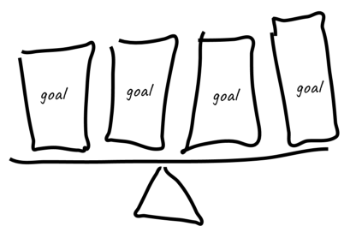
If there is more than one goal, then often some balancing act is needed. Even if the goals are few. If we only had a scale, it would tell us whether we are balancing the speed with which we progress towards each of the goals.
Attractive goals, unattractive path. For example, a good posture is a highly attractive goal: it helps preventing all sorts of pain. However, achieving and maintaining good posture might require constant investment: regular exercises, vigilance when sitting for prolonged amounts of time. Do I want that? Yes. Do I want to make the steps to get there? Maybe not. If I believe I am putting the effort in, do I? How would I know? Well, here we have the problem: an attractive goal does not achieve itself but requires regular effort, and continuous feedback on how I am doing. When gratification is delayed, a more deliberate, more thoughtful approach is required.
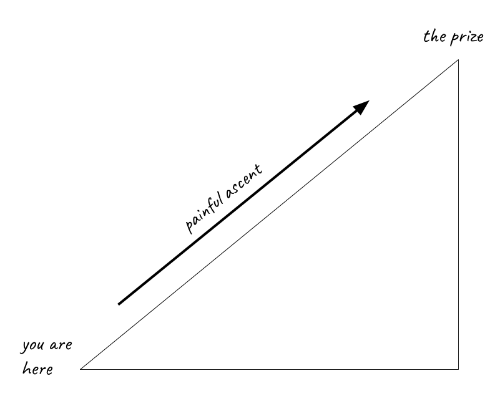
Sometimes there is a difficult path between you and your goal, which is perceived as painful. Gratification is delayed. What is required? Good aim (a map) and good feedback (a GPS) that all the tiny steps you do actually get you closer to the prize.
The non-goals. I believe that non-goals are as important as goals. It is impossible to make good progress towards goals without being willing to sacrifice on non-goals. For example, I will simply accept that I am not going to become a C++ expert / strong cyclist / etc. this year. There is just only so much time, so much willpower, so much effort that can be spent. Knowing what not to work on is as important, if not more important than working on something.
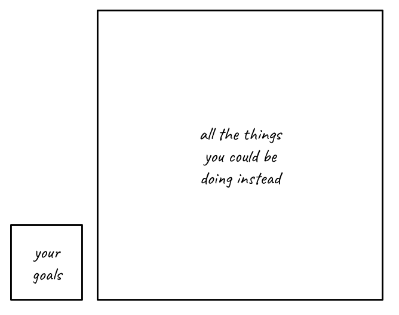
Focus is important. Even if your goals are big, there is a giant pool of non-goals; all the things you could aim for or could be spending your time, effort, and willpower on. Committing to a goal is in some way also a commitment to sacrifice; accepting that other things won’t happen, but also won’t distract.
Objectives and key results, or OKRs in short. OKRs are a means of setting a goal, and setting a way on measure progress towards that goal. See Measure What Matters: OKRs: The Simple Idea that Drives 10x Growth by John Doerr (https://g.co/kgs/NsBfMP). That fits right into the idea of big goals, but just in slightly different lingo. I like the following quote on (personal) OKRs:
“The objective is what I want to have accomplished. The key results are how I’m going to get it done. The objectives are typically longer lived. They’re bold and aspirational. The key results are aggressive, but always measurable, time-bound, and limited in number.” https://hbr.org/2018/05/how-vc-john-doerr-sets-and-achieves-goals.
So what? Earlier in 2020, I was missing a way to list, express and visualize my “personal OKRs”, A way to measure progress towards these goals. There are many habit tracker or goal tracker apps out there. But ultimately, I spent little market research and instead built an online app to suit my requirements, around my particular personality. The focus is on three P’s out of Neil Thubron’s 7P framework. purpose, pledge, perception which I summarize as follows:
- P for purpose: the why
- P for pledge: the commitment
- P for perception: the feedback
And how? For the techies among you, I built this app using Firebase, backed by Firestore with d3.js to render the content (https://github.com/jeadorf/pursuit). But the technical details are not in the focus of my article today: instead, I want to shine some light on what I think are important characteristics of this app to make it a useful and engaging rather than an annoying digital companion.
The pursuit app. Without further ado, let me first show you a screenshot of the pursuit app. This screenshot may explain more than a thousand words. Later I will explain some of the rationale on the choices made when building this app.
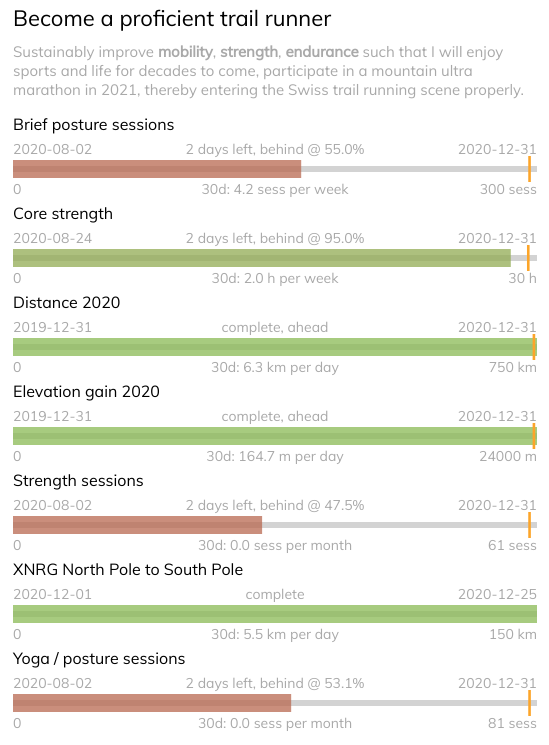
The pursuit app showing some my personal objective to get back into trail running after having moved to Switzerland. The orange bar shows the current date. Red color indicates poor performance, green color indicates good performance. A note below each progress bar indicates the velocity over the past 30 days.
Time bound, measurable key results. As mentioned before, quoting John Doerr, key results should be measurable and time bound. I have built this idea into the core of the pursuit app. If you remove the idea of time, you lose fast feedback on whether whatever you do is working. If you choose aggressive goals, then there is a good chance that things are not working and you better learn that earlier than later such that you can adapt your approach. This is also what I believe Neil Thubron describes in his framework: P for perception. Finally, thinking about what and how to measure is a healthy reality check on how well you know what you are actually aiming for.
Tracking effort versus desirable outcomes. To be honest, this is still a construction site, and in 2021 I want to get better at formulating key results in terms of outcomes rather than effort. In other words, I am interested more in measuring the return of investments rather than the investment itself. For example, I should train smart, putting the right mix between hill sessions, speed sessions, endurance sessions, recovery sessions, strength sessions rather than just putting in as many miles or elevation gain as I can. I will never be able to map the training plan into a set of key results, so instead it’s better to make plans separately and use key results to measure whether the plan is leading to the desired results. Right now, I track things like distance and elevation gain even though I probably want to set myself a benchmark─e.g. a particular running segment with certain elevation─that I can repeatedly evaluate myself against throughout the year. Yet, it is quite clear that if I do not put in continuous effort, I will certainly not make progress, so I can already get that feedback by measuring whether I succeed at putting in effort, regularly. This is important in exercise, because the overload principle states that if a system in the body is habitually overloaded, it will respond and adapt (https://www.coursera.org/learn/science-exercise). Failing to habitually exercise is therefore a show-stopper.
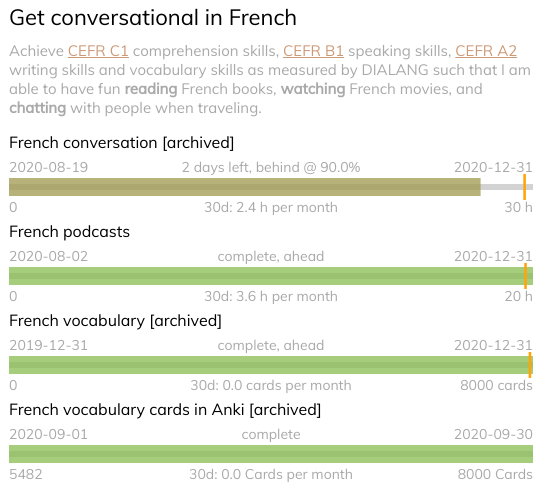
Learning French, but only part-time. Motivation is absolutely key in language learning (that’s P for purpose by Neil’s 7P framework). I only managed to get through 8000 vocabulary cards because I could see my continuous progress and speed in the app, and I knew exactly how many new cards to study every day, along with the knowledge that this approach to learning vocabulary is going to scale (http://www.athoughtabroad.com/2020/05/24/the-sublinearity-of-spaced-repetition-learning). By doing the DIALANG test before and after the whole effort, I seemed to have moved from vocabulary skills from A2 to B1.
Feedback is important. Fast feedback allows to change course early on, and abandon approaches that are not yielding the desired results. For example, I realized that the onset of winter would mean that if I keep running in the mornings, I won’t get daylight. In turn, I would not go running at all. Now, I go running before lunch and the problem is solved. The pursuit app gives first-order feedback (progress; think total distance travelled), and second-order feedback (velocity; think speed at which you are travelling). It’s important to look not only at how far you have gone, and how far it is still to go. Rather, it’s important to look how fast you are travelling at the moment and whether you are making progress in the only moment where you can affect the future: the present. The app shows thus both total progress as well as indicator for velocity.
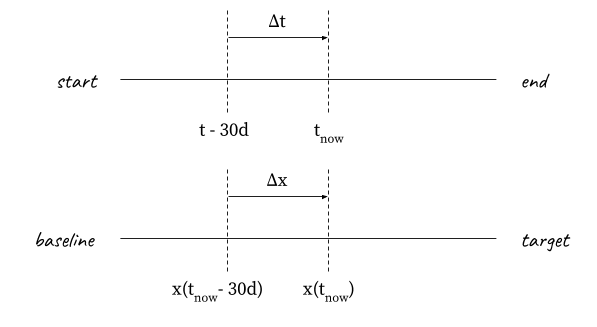
Each key result has a baseline, describing where you are at the start date. Each key result has a target, describing where you want to be at the end date. By looking back over the past 30 days, velocity can be estimated as Δx/Δt.
Balancing discipline and elasticity (I’m borrowing the terms “discipline” and “elasticity” from Perry Mehrling in Economics of Money and Banking: https://www.coursera.org/learn/money-banking). The app shows a gradient for each key result, in order to indicate whether total progress is on track to be met by the end date. Whether a key result is on track is based on the average velocity since the start date. This is a strong assumption because it assumes that progress towards a goal is linear. That is not always true and even during the course of a week, I may focus more on certain goals on some days. Thus, some elasticity is required, and small deviations from the required average velocity should not be indicated by screamingly bright red color. Instead, only give gradual signal when performance is slipping compared to the linear assumption. This avoids “alert fatigue”, getting used to ignoring the alarm signals because they are a common, everyday sight.
Fast and simple. The pursuit app is mobile-friendly and loads fast. It takes me three clicks and a mere few seconds to get from my smartphone home screen to the input box which allows me to update current progress. At first I thought it was a hassle having to manually update my progress, but then I realized that this is an incentive to regularly engage and look at my goals. Thus automation is not as important than a simple, responsive user interface.
What’s next? I have been using the app for almost half a year now, on a daily basis, and will continue to do so. My focus for 2021 is likely to move further towards including key results formulated as outcomes. I hope that this article inspired you, to work hard for what you really care for. I believe that persistence is key, particularly since 2021 will be a challenge again.